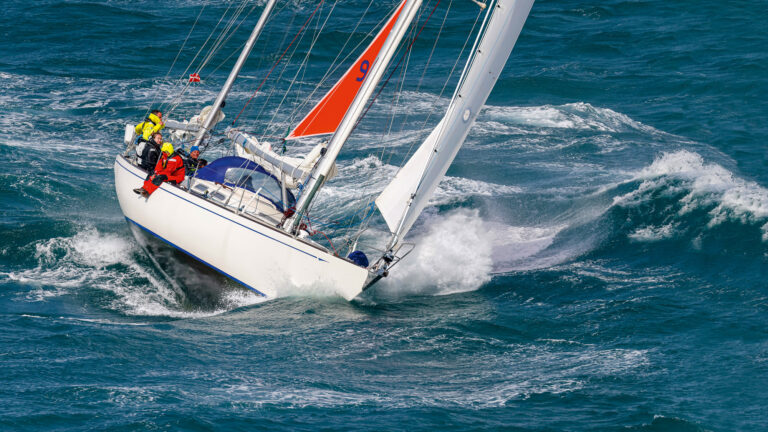Fitness And Training Routines for Professional Sailors
Fitness and training routines for professional sailors include a combination of exercises that improve cardiovascular endurance, strength, and agility. These routines typically involve a mix of aerobic activities such as running and swimming, calisthenics routines, and strength training sessions that focus on both the upper and lower body.
The Navy SEAL training schedule, for example, includes slow, long-distance workouts, high-intensity workouts, interval workouts, calisthenics routines, and strength training sessions for optimal physical fitness.
Following a well-rounded fitness and training routine is crucial for professional sailors to maintain their physical performance and overall health while out at sea.
Importance Of Fitness For Professional Sailors
Maintaining fitness is of utmost importance for professional sailors. By incorporating regular training routines into their lives, they can improve their strength, endurance, and agility, which are essential for their demanding profession at sea.
Maintaining peak physical fitness is crucial for professional sailors. The demanding nature of sailing requires sailors to have exceptional endurance, strength, agility, and flexibility. By focusing on fitness, professional sailors can enhance their overall performance and ensure their safety on the water.
Here are the key reasons why fitness is of utmost importance for professional sailors:
- Enhancing physical endurance and stamina: Sailing involves long hours on the water, often in challenging conditions. Building endurance and stamina ensures that sailors can withstand the physical demands of sailing for extended periods without compromising their performance.
- Improving core strength for stability: Core strength is vital for maintaining balance and stability while on a moving boat. Strong core muscles enable sailors to react quickly to changing conditions, maintain body control, and minimize the risk of injuries caused by falls or sudden movements.
- Enhancing agility and flexibility: Sailing requires sailors to maneuver swiftly and fluidly. By improving agility and flexibility, sailors can navigate in tight spaces, perform quick maneuvers, and adapt to changing wind and sea conditions with ease.
Sailors need to prioritize their fitness to excel in their profession. By focusing on these aspects of fitness, professional sailors can ensure that they perform at their best and have a safe and successful sailing experience.
Key Components Of Fitness Training For Sailors
Enhance fitness and training routines with key components tailored for professional sailors.
Improve cardiovascular endurance, strength, and core stability through exercises such as split lunges with a rotation, single-leg squats, shoulder taps, chin-ups, and bird dog movements.
Stay motivated and patient while enlisting the help of a fitness trainer to achieve optimal performance on the water.
Cardiovascular Endurance Training:
- Cardiovascular endurance training focuses on improving the heart and lungs’ ability to deliver oxygen to the muscles during physical activity.
- Sailors require good cardiovascular endurance to handle the demands of long hours at sea and to endure physically demanding tasks.
- Engaging in activities such as running, swimming, cycling, or rowing can help improve cardiovascular fitness.
- Aim for at least 150 minutes of moderate-intensity aerobic activity or 75 minutes of vigorous-intensity aerobic activity per week.
- Include interval training to enhance endurance and simulate the intensity changes experienced during sailing races or expeditions.
Strength Training:
- Strength training plays a crucial role in the physical preparation of sailors.
- Building and maintaining strength helps sailors handle the physical demands of sailing, such as pulling ropes, hoisting sails, and maneuvering the boat.
- Focus on exercises that target the major muscle groups, including the upper body, core, and lower body.
- Incorporate resistance training using weights, resistance bands, or bodyweight exercises.
- Aim for two to three sessions per week, allowing for adequate rest and recovery between sessions.
Flexibility Training:
- Flexibility training is essential for sailors to improve their range of motion and prevent injuries.
- It helps sailors perform maneuvers on the boat more effectively and reduces muscle tension and soreness.
- Incorporate dynamic stretching before physical activity to warm up the muscles and static stretching after activity to improve flexibility.
- Include exercises that target major muscle groups, such as the shoulders, back, hips, and legs.
- Aim for regular stretching sessions, focusing on both upper and lower body flexibility.
Cardiovascular Endurance Training
Cardiovascular endurance training is a crucial component of fitness and training routines for professional sailors. It helps improve stamina and endurance for long hours out at sea, allowing sailors to perform at their best during physically demanding tasks.
Benefits Of Cardiovascular Endurance For Sailors:
- Enhanced stamina and endurance during long sailing trips
- Improved circulation, delivering oxygen and nutrients efficiently to the muscles
- Increased lung capacity for better breath control in challenging weather conditions
- Reduced risk of cardiovascular diseases and improved overall heart health
- Enhanced recovery time after intense physical activities
- Improved mental focus and concentration during long periods at sea
Types Of Cardiovascular Exercises For Sailors:
Running:
- Running is a great way to improve cardiovascular endurance for sailors.
- It can be done on land or on a treadmill, allowing sailors to train even when they are not at sea.
- Running engages major muscle groups and increases heart rate, improving overall fitness levels.
- Sailors can incorporate interval training, hills, and long-distance runs to simulate different sailing conditions.
Swimming:
- Swimming is an excellent cardiovascular exercise that engages the entire body.
- It provides a low-impact workout, reducing the risk of injuries while improving endurance.
- Sailors can swim in pools or open water, replicating the conditions they may face during sailing.
- Different strokes and intervals can be incorporated to challenge and improve cardiovascular fitness.
Cycling:
- Cycling is another effective cardiovascular exercise for sailors.
- It builds leg strength while also improving overall cardiovascular fitness.
- Sailors can cycle outdoors or use stationary bikes indoors.
- Similar to running, interval training and longer rides can be incorporated to vary the training routine.
By incorporating these cardiovascular exercises into their training routines, professional sailors can enhance their endurance, improve their overall fitness levels, and perform better in challenging sailing conditions.
Strength Training For Sailors
Improve your sailing performance with strength training exercises designed specifically for professional sailors. Enhance your fitness and training routines to develop the strength and endurance needed for success on the water.
Importance Of :
Strength training plays a crucial role in the overall fitness and performance of professional sailors. Here’s why it’s essential:
- Enhances sailing-specific movements and maneuvers.
- Reduces the risk of injury by strengthening muscles and joints.
- Improves endurance, allowing sailors to handle long hours on the water.
- Increases power and explosiveness for swift and efficient movements.
- Helps maintain balance and stability on a moving vessel.
Upper Body Strength Exercises:
To develop upper body strength, professional sailors can incorporate the following exercises into their training routine:
- Pull-ups: This exercise targets the muscles in the back, arms, and shoulders. It helps build upper body strength and improves grip.
- Push-ups: An excellent compound exercise that engages multiple muscle groups, including the chest, shoulders, triceps, and core.
- Shoulder press: This exercise involves pressing a weight overhead, targeting the deltoids and triceps. It helps in raising and lowering sails effectively.
Lower Body Strength Exercises:
Strengthening the lower body is equally important for a well-rounded sailor’s fitness routine. Here are some exercises to focus on:
- Squats: A fundamental lower body exercise that targets the quadriceps, hamstrings, and glutes. It improves leg strength and stability.
- Lunges: Another great exercise that engages the quads, hamstrings, and glutes. It helps develop stability and mobility in the lower body.
- Deadlifts: This exercise primarily targets the posterior chain, including the hamstrings, glutes, and lower back. It enhances overall strength and power.
Remember, while performing these exercises, sailors should start with lighter weights and gradually increase the intensity as their strength improves. Consistency and proper form are key to achieving optimal results.
Flexibility Training For Sailors
Improve fitness and training routines for professional sailors with flexibility training. Enhance performance and prevent injuries with a variety of exercises designed to increase range of motion and mobility on the water.
Importance Of Flexibility For Sailors:
- Flexibility plays a crucial role in the performance and overall well-being of professional sailors.
- Having good flexibility helps sailors maintain proper posture, balance, and stability while on the water.
- Improved flexibility reduces the risk of injuries, such as muscle strains and sprains.
- Flexibility training enhances the range of motion in joints, allowing sailors to maneuver more effectively.
- Stretching exercises also contribute to better recovery after intense sailing sessions.
Stretching Exercises For Improved Flexibility:
- Incorporating stretching exercises into a regular fitness routine can significantly improve flexibility for sailors.
- Stretching should be done after a warm-up to increase blood flow to the muscles and make them more receptive to stretching.
- Aim to hold each stretch for 20-30 seconds, without bouncing or forcing the movement.
- Focus on major muscle groups used during sailing, such as the hamstrings, quadriceps, and shoulders.
- Here are some effective stretching exercises for improved flexibility:
Hamstring Stretches:
- Stand with your feet hip-width apart, and slowly bend forward from the hips, reaching towards your toes.
- Keep your back straight and avoid rounding your spine.
- Hold the stretch for 20-30 seconds, feeling the stretch in the back of your thighs.
- Repeat the stretch on both sides for optimal results.
Quadricep Stretches:
- Stand tall and balance on one leg.
- Bend your other knee and grab your ankle behind you.
- Gently pull your ankle towards your buttocks while keeping your knees close together.
- Hold the stretch for 20-30 seconds, feeling the stretch in the front of your thigh.
- Repeat the stretch on both sides.
Shoulder Stretches:
- Stand or sit up straight with your feet shoulder-width apart.
- Extend one arm across your chest, using your other arm to gently pull it closer to your body.
- You should feel the stretch in the back of your shoulder.
- Hold the stretch for 20-30 seconds and repeat on the other side.
By incorporating these stretching exercises into their training routines, professional sailors can enhance their flexibility, improve performance, and reduce the risk of injuries on the water. Remember to prioritize safety and listen to your body’s limitations while stretching.
Nutrition For Professional Sailors
Maintaining a proper fitness and training routine is essential for professional sailors. By incorporating exercises that focus on core strength, cardiovascular endurance, and upper body strength, sailors can enhance their performance on the water and improve their overall fitness levels.
Importance Of Proper Nutrition For Performance:
- Proper nutrition plays a vital role in the performance of professional sailors. It provides the necessary fuel and nutrients to support their physical and mental demands during long hours at sea.
- A balanced and nutrient-rich diet helps sailors stay energized, maintain a healthy weight, and recover faster from intense training sessions and competitions.
- Good nutrition also boosts the immune system, reduces the risk of injuries, and improves overall well-being, allowing sailors to perform at their best.
Essential Nutrients For Sailors:
Sailors require specific nutrients to meet the demands of their physically challenging profession. Here are the essential nutrients they need to prioritize in their diet:
Carbohydrates:
- Carbohydrates are the primary source of energy for sailors. They provide readily available fuel for the muscles and brain.
- Opt for complex carbohydrates like whole grains, fruits, vegetables, and legumes. These foods release energy slowly, providing sustained fuel for long periods at sea.
- Limit the consumption of refined carbohydrates, such as sugary snacks and drinks, as they can lead to energy crashes and fluctuations.
Proteins:
- Proteins are crucial for building and repairing muscles, supporting the immune system, and aiding in recovery. Sailors require an adequate protein intake to sustain their physical exertion.
- Include lean sources of protein in the diet, such as fish, poultry, eggs, tofu, legumes, and dairy products. These foods are rich in amino acids, the building blocks of proteins.
Healthy Fats:
- Healthy fats are essential for sailors as they provide long-lasting energy, help absorb fat-soluble vitamins, and support brain function.
- Incorporate sources of healthy fats like avocados, nuts, seeds, olive oil, and fatty fish into the diet. These fats are rich in omega-3 fatty acids, which have anti-inflammatory properties and promote cardiovascular health.
Hydration Tips For Sailors:
Staying hydrated is crucial for sailors to maintain optimal performance and prevent dehydration. Here are some hydration tips to keep in mind:
- Drink water regularly throughout the day, even if you don’t feel thirsty. Thirst is not always an accurate indicator of hydration status.
- Aim to consume at least 8-10 cups (64-80 ounces) of water daily, depending on individual needs and environmental conditions.
- Avoid excessive consumption of caffeinated and sugary drinks, as they can dehydrate the body.
- Carry a reusable water bottle on board and make it a habit to sip water frequently.
- Consider using electrolyte-enhanced beverages or adding electrolyte powder to your water to replenish electrolytes lost through sweat.
Remember, proper nutrition and hydration are essential components of a professional sailor’s training routine. By fueling their bodies with the right nutrients and staying hydrated, sailors can optimize their performance and sail to success.
Mental Fitness For Professional Sailors
Discover effective fitness and training routines tailored specifically for professional sailors. Enhance mental fitness, endurance, strength, and core stability with targeted exercises designed to optimize performance on the water.
Importance Of Mental Fitness In Sailing:
Sailing is not just about physical strength and skill; it requires mental fitness as well. The mental aspect of sailing plays a crucial role in decision-making, focus, and resilience. Here are the reasons why mental fitness is important for professional sailors:
- Decision-making: Making split-second decisions is essential in sailing. Mental fitness allows sailors to analyze various factors and make informed decisions quickly.
- Focus: Sailing involves long hours on the water, and maintaining focus is vital. Mental fitness helps sailors stay focused on the task at hand and avoid distractions.
- Resilience: Sailing can be challenging and unpredictable, with adverse weather conditions and intense competition. Mental fitness helps sailors stay resilient and bounce back from setbacks.
- Confidence: Mental fitness builds confidence, enabling sailors to trust their abilities and instincts in high-pressure situations.
Techniques For Maintaining Mental Focus And Resilience:
- Meditation: Practicing meditation helps sailors calm their minds, improve focus, and enhance mental clarity.
- Visualization: Visualizing successful outcomes and positive experiences before a race can boost confidence and mental preparedness.
- Goal Setting: Setting clear and achievable goals helps sailors stay motivated and focused on their objectives.
- Positive Self-Talk: Encouraging self-talk can help sailors maintain confidence and resilience during challenging times.
- Mindfulness: Being mindful and present in the current moment helps sailors stay focused and aware of their surroundings.
Stress Management Strategies For Sailors:
- Breathing Techniques: Deep breathing exercises can help sailors reduce stress and anxiety, promoting a state of relaxation.
- Physical Exercise: Engaging in regular physical exercise not only improves physical fitness but also helps manage stress and enhance mental well-being.
- Time Management: Effective time management allows sailors to prioritize tasks and reduce stress caused by tight schedules.
- Social Support: Building a strong support network of fellow sailors or mentors provides sailors with emotional support and a sense of belonging.
- Rest and Recovery: Getting sufficient rest and prioritizing recovery allows sailors to recharge both physically and mentally, reducing the risk of burnout.
Remember, mental fitness is as important as physical fitness in sailing. By incorporating techniques for maintaining mental focus and resilience and employing effective stress management strategies, professional sailors can enhance their overall performance and achieve success on the water.
Recovery And Injury Prevention For Sailors
Enhance your fitness and training routines as a professional sailor with our comprehensive recovery and injury prevention strategies. From tailored exercises to improve strength and endurance to expert tips on preventing common sailing injuries, we have you covered. Stay at the top of your game and sail with confidence.
Importance Of Recovery For Sailors:
- Sailors undergo intense physical and mental exertion while training and competing, making recovery crucial for their overall performance.
- Proper recovery allows sailors to repair and strengthen their bodies, reducing the risk of injuries and improving resilience.
- Sailors need to prioritize recovery to maintain peak performance levels and avoid burnout.
Techniques For Proper Recovery:
Rest and sleep:
- Getting adequate sleep is essential for sailors to recharge their bodies and minds.
- Aim for 7-9 hours of uninterrupted sleep each night to promote optimal recovery.
- Napping during the day can also be beneficial for quick rejuvenation.
Massage and foam rolling:
- Regular massage therapy can help sailors alleviate muscle tension and improve blood circulation.
- Foam rolling is another effective technique for releasing muscle tightness and improving flexibility.
- Incorporate self-massage or seek professional assistance to target specific areas of soreness or tension.
Active recovery exercises:
- Engaging in light exercises on rest days promotes active recovery.
- Activities like swimming, yoga, or cycling can help increase blood flow and flush out metabolic waste.
- Avoid high-intensity workouts on recovery days to allow the body to recover fully.
Injury Prevention Tips For Sailors:
Maintain proper form and technique during training:
- Ensure that sailing movements are executed with correct alignment and body mechanics.
- Seek guidance from experienced trainers or coaches to avoid putting unnecessary strain on the body.
Strengthen supporting muscles:
- Focus on strengthening the core, upper body, and lower body muscles to provide better support and stability while sailing.
- Incorporate exercises like planks, push-ups, lunges, and squats into your training routine.
Warm-up and cool-down:
- Always start your sailing sessions with a dynamic warm-up to prepare the body for the physical demands.
- Cool down with static stretches to improve flexibility and reduce muscle soreness.
Stay hydrated and fuel properly:
- Drink enough water throughout the day to avoid dehydration during training or competitions.
- Consume a well-balanced diet that includes carbohydrates, proteins, and healthy fats to support optimal performance and recovery.
Listen to your body:
- Recognize the signs of fatigue or discomfort and adjust your training accordingly.
- Pushing through pain or ignoring warning signs can lead to injuries that may hinder your sailing progress.
Sailors should prioritize recovery as a vital component of their training routine to ensure they can perform at their best while minimizing the risk of injuries. By incorporating proper recovery techniques and following injury prevention tips, sailors can maintain their physical and mental well-being to excel in their sailing endeavors.
Frequently Asked Questions On Fitness And Training Routines For Professional Sailors
What Is The Navy Workout Routine?
The Navy workout routine includes slow, long-distance running and swimming, high-intensity workouts, interval training, calisthenics, and strength training sessions for the upper and lower body.
What Exercises Are In Navy Physical Training?
Navy physical training includes running, toe raises, push-ups, curl-ups, and other exercises.
How Do Sailors Workout?
Sailors workout with exercises like split lunges, single-leg squats, shoulder taps, chin-ups, and bird dogs.
How Do You Stay Fit While Sailing?
To stay fit while sailing, try these exercises: – Core exercises such as split lunges with rotation and single-leg squats. – Upper body exercises like chin-ups and bird dogs. – Enlist the help of a fitness trainer and focus on cardiovascular endurance training. – Stay motivated, be patient, and maintain a consistent workout routine.
Conclusion
Professional sailors require a robust fitness and training routine to excel in their demanding sport. By incorporating a variety of exercises into their regimen, sailors can enhance their strength, endurance, and agility on the water. It is crucial for sailors to focus on core exercises that target their abdominal muscles, as a strong core is essential for stability and balance.
Additionally, incorporating cardiovascular exercises such as swimming and running helps to improve overall endurance. Strength training exercises, including upper and lower body workouts, are also vital for sailors to develop the necessary power and muscular strength required for sailing. Furthermore, a comprehensive training routine should include exercises that specifically target the muscles used in sailing, such as the shoulders, back, and legs.
By following a well-rounded fitness and training routine, professional sailors can optimize their performance and achieve success in their sailing endeavors. Remember, consistency and dedication are key to reaching peak physical condition for sailing.








